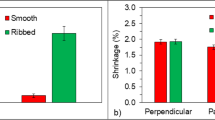Abstract
The author describes the specifics of molds for quasi-isostatic molding, which provide volumetric compression of preforms made of powdered materials and their waste-free production technology. The advantages of these molds compared to isostatic molds are discussed.
Similar content being viewed by others
References
M. I. Timokhova, “Quasi-isostatic molding of articles from powdered materials,” Nov. Ogneupory, No. 11, 31–34 (2003).
M. I. Timokhova, “Quasi-isostatic molding as promising technology for production of refractories,” Nov. Ogneupory, No. 6, 19–23 (2004).
M. I. Timokhova, “Volumetric quasi-isostatic molding of powder materials,” Nov. Ogneupory, No. 12, 43–44 (2004).
M. I. Timokhova, “Some vibration methods in isostatic molding technology,” Nov. Ogneupory, No. 6, 13–16 (2006).
Author information
Authors and Affiliations
Additional information
__________
Translated from Novye Ogneupory, No. 12, pp. 18–22, December, 2006.
Rights and permissions
About this article
Cite this article
Timokhova, M.I. Design specifics of quasi-isostatic molds. Refract Ind Ceram 47, 344–347 (2006). https://doi.org/10.1007/s11148-007-0004-x
Received:
Issue Date:
DOI: https://doi.org/10.1007/s11148-007-0004-x




